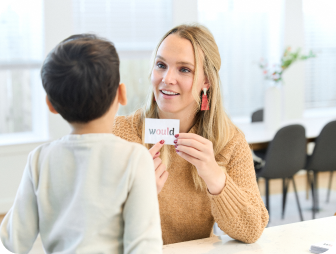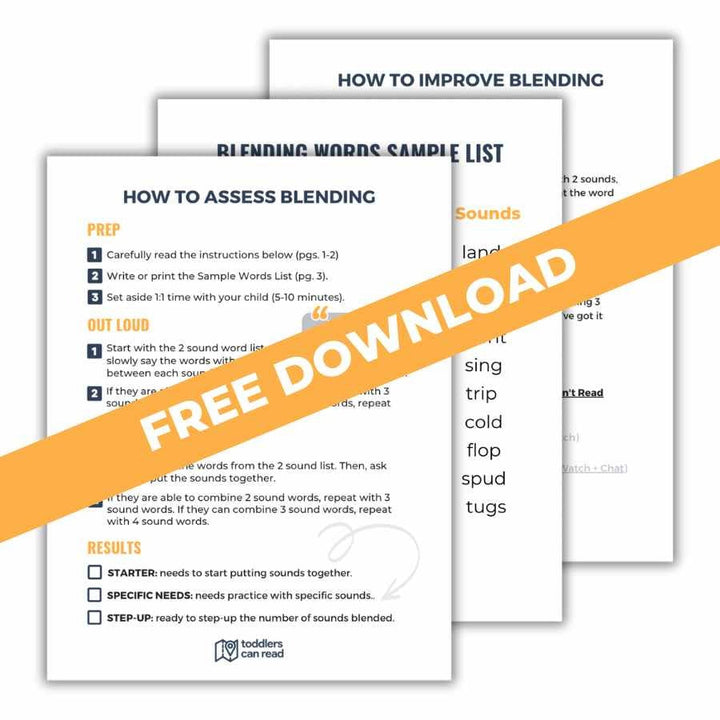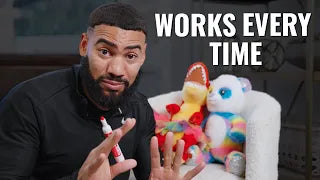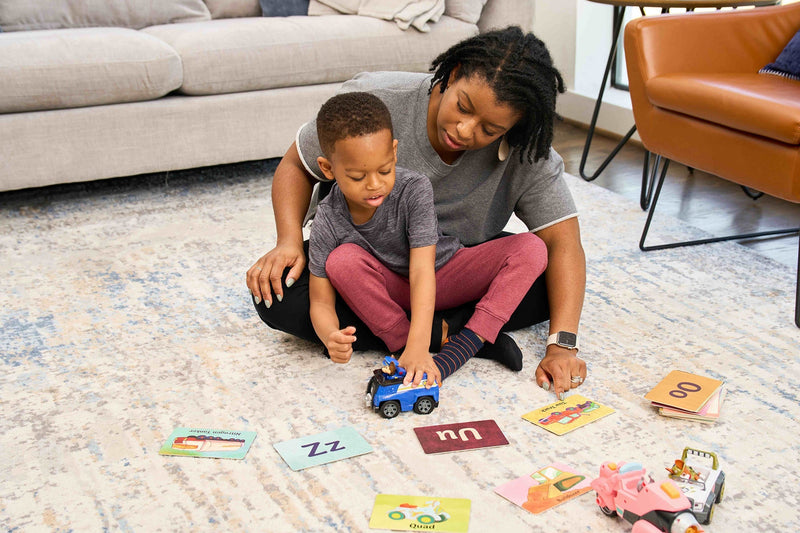Many kids master the first step toward reading—letter sounds—pretty quickly. After all, learning “p” says “puh” is no different from learning a duck says quack. But the next step toward reading independently is a big step, and lots of families get stuck trying to bridge the gap between letters and words.
If you’re excited to support your kid’s reading journey, but you’re also feeling helpless about teaching them more difficult skills, you’re not alone.
The Lovevery Reading Skill Set can help!
Lovevery Reading Skill Set or Toddlers Can Read?
In addition to teaching storytelling, Part 2 of the Lovevery Skill Set is designed to help kids master blending—much like the Toddlers Can Read Blending Course. And while it may seem strange that I’m writing about a “competitor’s” product, I’m doing so with good reason.
First, I joined forces with Lovevery as their Head of Literacy Strategy just as they were introducing parents to their Reading Skill Set. That means Lovevery and TCR aren’t competitors at all. We’re both committed to screen-free, play-based learning, and intentional parenting, and we’re both deeply engaged in the fight against illiteracy.
Second, I’m serious about helping parents teach their kids to read, which means helping you take full advantage of whatever resource you choose. And with that elephant now out of the room, let’s take a tour of the Lovevery Reading Skill Set Part 2, Words to Books.
If you’re trying to decide between the two programs, check out my honest review of the Lovevery Reading Skill Set.
Age and Stage
Part 2 of Lovevery’s Reading Skill Set works on skills most commonly taught in Kindergarten and 1st Grade. Your child is ready for these games and activities if they:
- Identify the starting and ending sounds of spoken words
- Recognize letters and know their most common sounds
- Read simple 3-sound words (cat, dog, box)
If you think your child might need more practice on these foundational skills, consider Part 1 of the Reading Skill Set. Or, if your child is a bit older, can already read words with short vowel sounds, and can read and spell words with consonant blends, consider Part 3 instead.
Games, Activities, and Books
Part 2 of the Reading Skill Set includes 7 skill-based games and activities and 13 confidence-boosting books. You also receive a Play Guide and access to an online portal, which means there’s no parent expertise required.
Play Guide
Having a basic understanding of why you’re teaching each reading skill can help make learning time more effective. You’ll find all that information and more inside the Play Guide. (If you’re a Lovevery Play Kit subscriber, the Play Guide will feel familiar!)
Tip: Before you invite your child to learn and play, take a few minutes to review the relevant section of the Play Guide. You’ll feel more confident instructing your child, and you’ll both be less frustrated.
Mystery Word Decoder

Goal: Blend letter sounds.
Play: Invite your child to select a mystery pattern card and then slot in the letter cards that match the pattern. With all three letter cards in place, ask your child to blend the letter sounds together to read the mystery word. They can check their work by flipping over the corresponding image on the board to see if the patterns match.
Tip: When your child seems comfortable with the goal of the game, let them play on their own. Stay nearby, though, so you can lend a hand if they get stuck. Blending sounds into words can be tricky!
Totally Decodable Book Series

Goal: Build confidence decoding (sounding out) words.
Play: Invite your child to “warm up” by reading the skill words at the start of each book. Then go page-by-page, allowing them to set the pace. There’s no need to rush!
Tip: Resist the temptation to jump in and “rescue” your child when they seem stuck. For example, instead of sounding out a word for them, guide them to use the skills they’ve learned so far. It might sound like this: “I see you’re having a little trouble with this word. Let’s break it down. Remind me what sound this letter makes.”
For more blending and reading practice, pick up a set of Toddlers Can Read decodable books.
Wooden Letter Sound Tiles
You’ll use this piece of the Reading Skill Set in conjunction with other games and activities included in Part 2. You can also use them in free play to practice spelling.

Sound Swap & Drop

Goal: Build sound flexibility by discovering how changing just one letter creates a brand new word.
Play: Take turns swapping out letters on the board to create new words. Continue until one of you runs out of letters or you’ve created all the words you can.
Tip: After you’ve played together, allow your child to keep exploring on their own. Sound Swap & Drop includes two independent play options: Sound Slide and Link. Check your Play Guide for simple directions.
Sticky Word Snack Sticks

Goal: Become familiar with words that have sticky bits—parts that don’t follow the regular phonics rules.
Play: Take turns choosing snack sticks from each other’s cups. If the stick has a word on it, invite your child to read it. If the stick has an ant, see if they can make a rhyme with a word they’ve already chosen. If the stick has a ladybug, invite them to read every word they’ve collected so far. And for inchworms, ask them to use one of their words in a sentence. If one of you draws three bugs in a row, the game is over, and you get to start again!
Tip: Avoid treating these like “sight words” that can be learned only through memorization. Through reading science, we know kids learn sticky words best when they use phonics skills to sound out the parts of the words that follow the rules and only memorize the parts that don’t. You’ll notice this game uses repetition to make memorization easier.
The Toddlers Can Read Advanced Sound Flashcards provide another way to reinforce sticky words.
Short Vowel Sound Book Series

This five-book set reinforces short vowel sounds, one vowel at a time. Be sure to let your child read these books. If you read them, your kid will likely memorize the stories instead of using their growing phonics skills.
Crossword Builder

Goal: Practice consonant blends (two consonants next to each other).
Play: Using the Crossword Builder Activity Booklet as a reference, ask your child to choose a puzzle setup. Then, encourage them to use the Wooden Letter Sound Tiles to spell out the words.
Tip: Be sure your child goes through the Activity Booklet in order, growing their skills as they go. If they choose too tricky a puzzle, they may become frustrated and want to quit. Going at your child’s pace is key!
Consonant Blends Book Series

Through the five books in this series, your child will reinforce their knowledge of consonant blends. Be sure to complete the interactive elements to keep learning fun!
Story Order Cards

Goal: Learn story structure to support reading comprehension.
Play: Invite your child to select one of the 10, color-coded stories in the kit. Ask them to put the cards in logical order—beginning, middle, end. Then, ask them to tell you the story they’ve created, touching each card to reinforce the story’s structure.
Tip: To encourage creativity, ask open-ended questions about the stories your child makes up. For example, in the purple card set, you might ask questions like, “What do you think the dog’s name is? What do you like to eat with your pancakes?”
Set the Scene Storytelling Stage
Goal: Build oral storytelling skills.
Play: Choose a Story Starter card, and then work together to set the scene described on the card. Invite your child to tell the story using the included scenes, props, and characters. To extend play time and foster creativity, introduce Story Twist Cards.
Tip: Kids love to tell silly, improbable stories. Let their imagination run as they share the what, where, who, why, and when of their story.
The Science
If you’re a parent who likes to nerd-out on reading science and understand the why behind the games and activities, consider the Toddlers Can Read Blending Words online course as a companion to Part 2 of the Lovevery Reading Skill Set.
Blending Sounds is also an ideal alternative for parents with kids younger than 3 (because of the small pieces in the Reading Skill Set), those with older kids (ages 8 and up), or those who prefer a more direct instruction approach.
As always, if we can be of any help, we’re here for you! Reach out to support@toddlersread.com.








